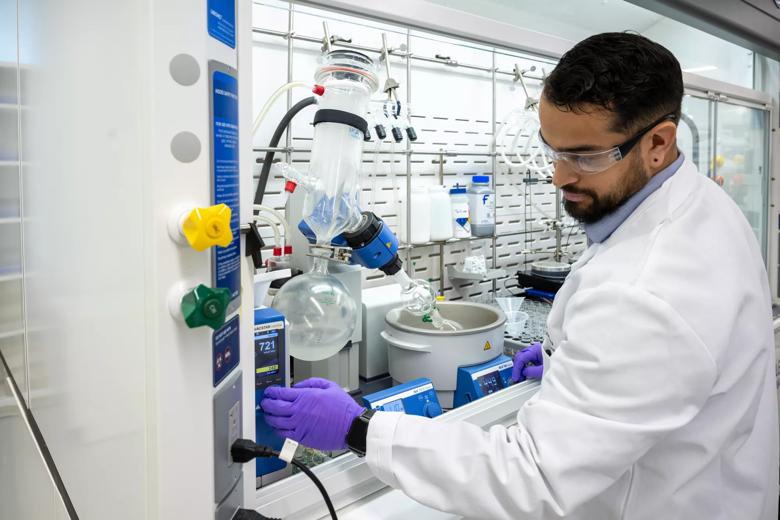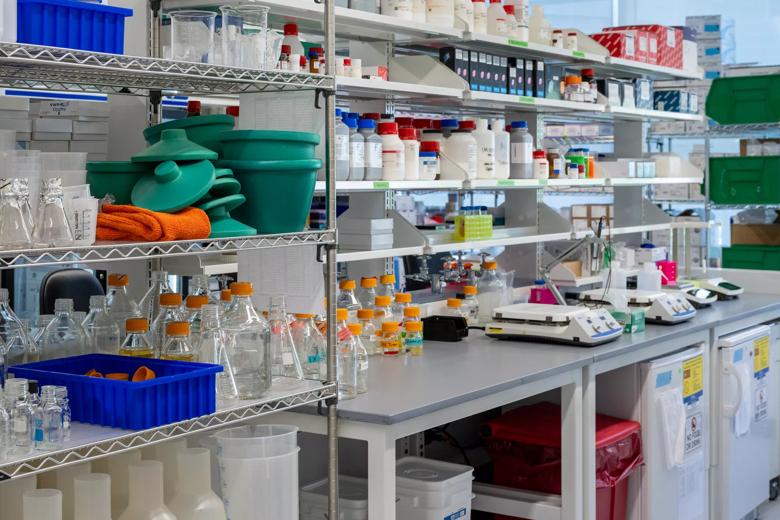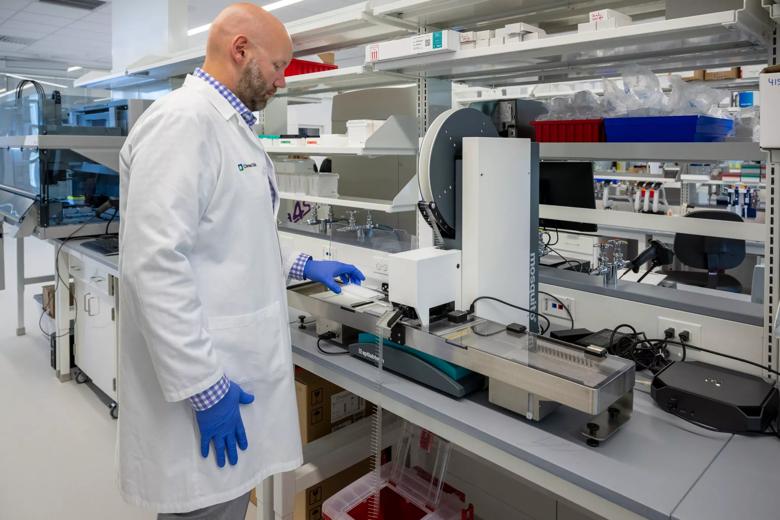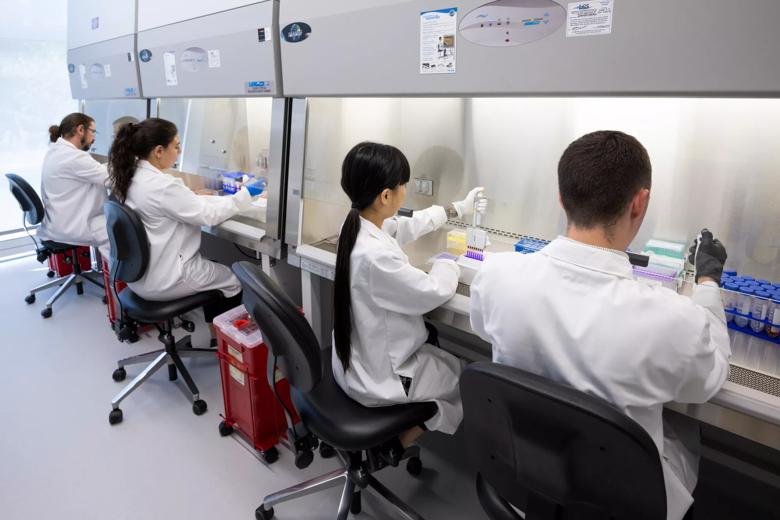Opens expanded research space and announces construction of two new research buildings
images: 8
video: 0
audio: 0
text: 0
Content is property of Cleveland Clinic and for news media use only.


As part of the Cleveland Innovation District, Cleveland Clinic has opened the first phase of its expanded research facilities and announced plans to launch major construction of two new research buildings. The state-of-the-art facilities will be dedicated to scientific investigation and will significantly increase laboratory research space on Cleveland Clinic’s main campus.
The Cleveland Innovation District, a unique public-private initiative, brings the State of Ohio and JobsOhio together with Cleveland’s healthcare and higher education institutions to create jobs, accelerate research and educate the workforce of the future.
“These new research facilities mark a significant step in our commitment to the Cleveland Innovation District, representing the largest research investment in our history,” said Tom Mihaljevic, M.D., Cleveland Clinic CEO and President, and holder of the Morton L. Mandel CEO Chair. “Our focus on innovation not only helps to develop new treatments to improve patient care, but also contributes to the growth of our region’s economy and efforts to train the workforce of tomorrow.”


Opening this month is 45,000 square feet of remodeled space to house leading-edge laboratories. Several of Cleveland Clinic’s fastest-growing research programs have moved to the space including the Center for Computational Life Sciences, Center for Immunotherapy and Precision Immuno-oncology that includes the Cell Therapy Program, and vaccine development. It also includes the Center for Therapeutics Discovery, which features floor-to-ceiling glass walls, providing a “science on display” feature with a view of scientists at work.
Cleveland Clinic is also opening a new biosafety level 3 laboratory for sophisticated pathogen research. The biosafety lab will enable researchers to expand their work to investigate infectious pathogens. The facility operates under stringent biosafety protocols set by the Centers for Disease Control and provides an important resource for scientists to safely develop diagnostics, treatments and vaccines to prevent and treat infectious diseases.
Next year, Cleveland Clinic plans to begin major construction on two new research buildings, totaling approximately 296,000 square feet, on Cedar Avenue and E. 100th Street in Cleveland’s Fairfax neighborhood. Featuring research laboratories, dedicated classroom space, offices and a café, the buildings will also include additional green space, landscaping and walking paths that will offer a new entrance to the southeast section of the main campus. Construction is expected to be completed in 2025.
The new buildings will be home to the Sheikha Fatima bint Mubarak Global Center for Pathogen Research and Human Health, the largest research initiative in Cleveland Clinic’s more than 100-year history. Headquartered in Cleveland, the center positions Ohio at the forefront of pathogen research.
“These new state-of-the-art research facilities will provide the infrastructure and technology necessary to grow Cleveland Clinic’s research efforts,” said Serpil Erzurum, M.D., Cleveland Clinic’s Chief Research and Academic Officer. “They will be a tremendous resource for our scientists in the Sheikha Fatima bint Mubarak Global Center for Pathogen Research and Human Health, enabling them to expand their vital work in preparing for the next pandemic, and discovering and developing critically needed new therapies and vaccines.”
In addition, Cleveland Clinic has made significant progress in its commitment to the Cleveland Innovation District, including:
Philanthropic funding has supported the Cleveland Innovation District. To date, more than $47 million has been raised from individuals, corporations and foundations. In addition, annual donor support fuels ongoing research programs at Lerner Research Institute with more than $17 million raised to date this year.
“JobsOhio and our State partners invested in the Cleveland Innovation District to spur the next generation of Ohio leaders while establishing the state as a global leader in healthcare, life sciences, and technology. Collectively, the region’s dynamic healthcare and higher education research institutions will serve as a magnet to retain and attract elite talent from home and around the world to Northeast Ohio,” said J.P. Nauseef, JobsOhio president and CEO. “In this case, the rapid pace of development being led by Cleveland Clinic on its main campus is bringing cutting-edge research facilities to the Cleveland Innovation District. These facilities are critical for the advancement of the pioneering research being led by Ohioans and eventually brought to scale worldwide.”

Researchers in Cleveland Clinic’s Center for Therapeutics Discovery are focused on translating basic science discoveries into new therapeutics for patients.

State-of-the-art equipment and facilities in Cleveland Clinic’s Center for Therapeutics Discovery, part of the Cleveland Innovation District.

The new spaces include critical equipment for expanding Cleveland Clinic’s research.

Medicinal chemistry researcher Steven Martinez works under a chemical fume hood. Moving into the new space expanded the number of fume hoods available from 12 to 19, including a floor to-ceiling hood, adding to the center’s capacity.

Scientists work in a new lab dedicated to vaccine development on Cleveland Clinic’s main campus.

In the Center for Therapeutics Discovery, the team tests new compounds developed at the center to ensure the desired effect occurs in cells, an important step in developing treatments.
Cleveland Clinic is a nonprofit multispecialty academic medical center that integrates clinical and hospital care with research and education. Located in Cleveland, Ohio, it was founded in 1921 by four renowned physicians with a vision of providing outstanding patient care based upon the principles of cooperation, compassion and innovation. Cleveland Clinic has pioneered many medical breakthroughs, including coronary artery bypass surgery and the first face transplant in the United States. Cleveland Clinic is consistently recognized in the U.S. and throughout the world for its expertise and care. Among Cleveland Clinic’s 82,600 employees worldwide are more than 5,786 salaried physicians and researchers, and 20,700 registered nurses and advanced practice providers, representing 140 medical specialties and subspecialties. Cleveland Clinic is a 6,728-bed health system that includes a 173-acre main campus near downtown Cleveland, 23 hospitals, 280 outpatient facilities, including locations in northeast Ohio; Florida; Las Vegas, Nevada; Toronto, Canada; Abu Dhabi, UAE; and London, England. In 2024, there were 15.7 million outpatient encounters, 333,000 hospital admissions and observations, and 320,000 surgeries and procedures throughout Cleveland Clinic’s health system. Patients came for treatment from every state and 112 countries. Visit us at clevelandclinic.org. Follow us at x.com/CleClinicNews. News and resources are available at newsroom.clevelandclinic.org.
Editor’s Note: Cleveland Clinic News Service is available to provide broadcast-quality interviews and B-roll upon request.